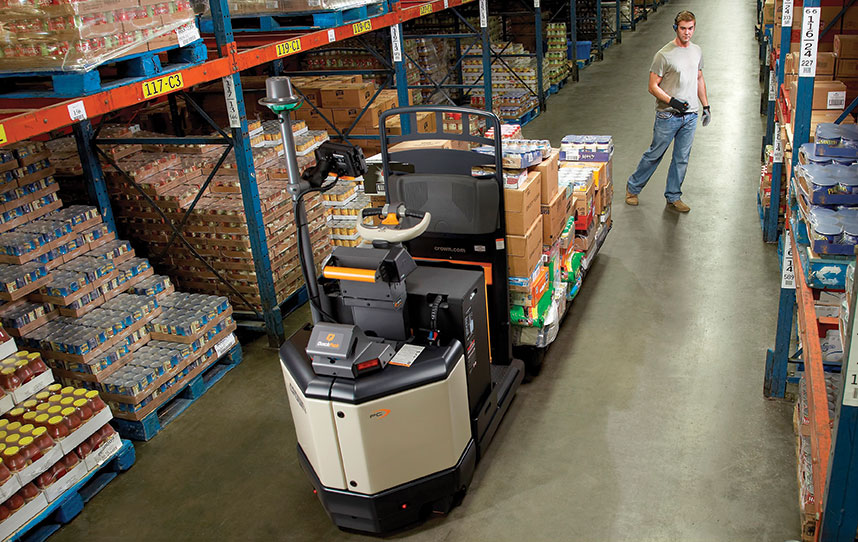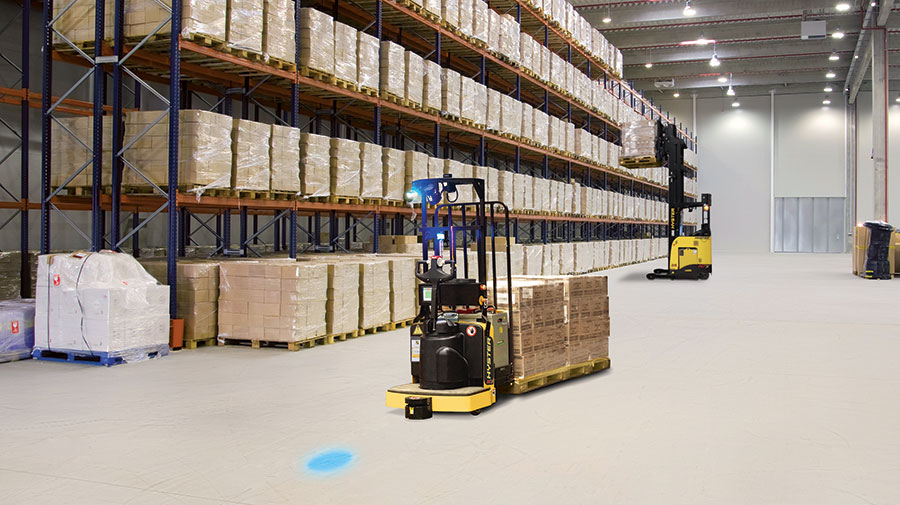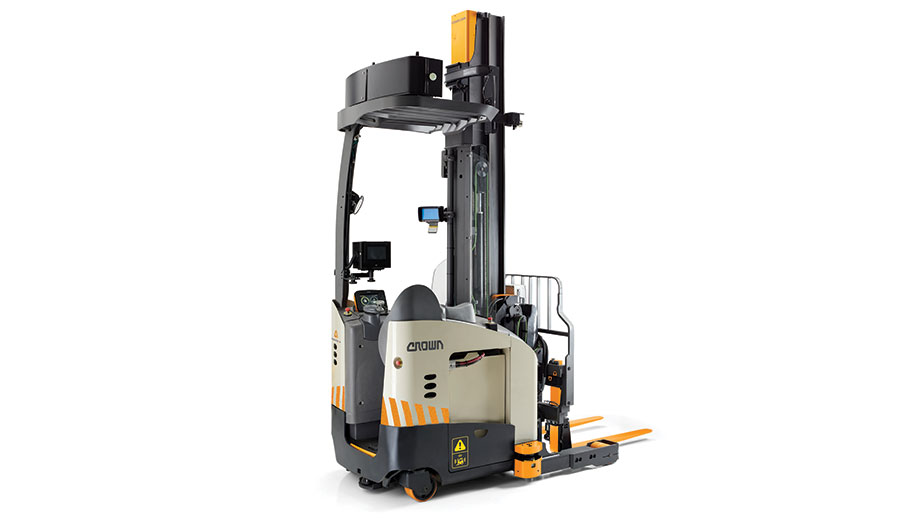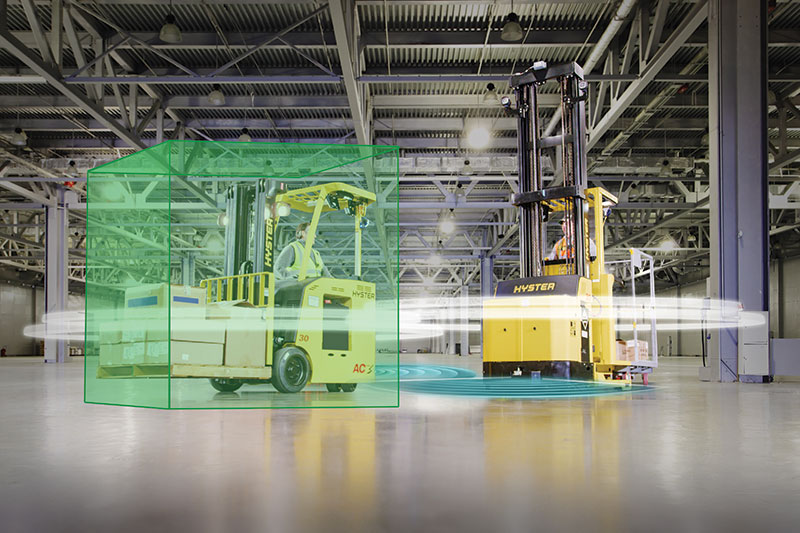Lift Truck Series: Lift trucks take the path to autonomy
Once considered the purvey of the far-off future, autonomous lift trucks have arrived. Here’s what they can offer.
 Not long ago, people would have raised eyebrows at the prospect of autonomous lift trucks on the warehousing floor. After all, lift truck drivers were real people in need of real jobs. Not only that, but the decision making required for safely and efficiently operating lift trucks was something best left to humans. Machines were a long way off in their ability to perform human-directed tasks.
Not long ago, people would have raised eyebrows at the prospect of autonomous lift trucks on the warehousing floor. After all, lift truck drivers were real people in need of real jobs. Not only that, but the decision making required for safely and efficiently operating lift trucks was something best left to humans. Machines were a long way off in their ability to perform human-directed tasks.
Enter the labor shortage, an e-commerce explosion, and massive supply chain disruptions and many warehousing executives—and operators themselves—are starting to change their tune.
“There just isn’t enough head count to cover the requirements on the warehouse floor,” says Nic Temple, director of business development for Hyster. “Ultimately, there’s a need for automation to supplement human labor.”
Jeff Christiansen, vice president of product at Seegrid Corp., agrees, and points to the perfect storm of conditions for driving the new acceptance of a more automated class of trucks. “There are pressures coming in from all sides,” he says, “including the demand for mass customization, the labor shortage, and of course, the rise in e-commerce.”
With all those factors hitting companies at once, the best strategy is the lowest risk path to success, says Christiansen. “Think about your operations,” he says. “You have an existing facility and processes. You’re short on people but high on demand. Rather than change all your facilities and processes, look for ways to obtain a higher productivity level within these challenges.”
These factors make autonomous lift trucks a viable option. As the design of trucks progresses and manufacturers continue to add more features and technology, the warehousing industry is embracing automated options more every day. “Overall, we’re still in the early days,” says Christiansen. “The most progressive companies are starting to adopt automation, but we’re still in the single digits percentage wise. But those getting their feet wet are the companies who will succeed in the future.”
Susan Comfort, senior manager of technology solutions and marketing at Raymond Corp., says the company factors in current supply chain trends to all of their designs. “Our strategy is to help customers navigate through all the factors impacting their operations,” she says, “which are ever changing.”
Options for autonomous
These vehicles can operate autonomously, receiving tasks from a warehouse management system (WMS); or, when needed, can be driven by an operator like a conventional lift truck. Some discussion exists around what to call these vehicles with some calling them hybrid lift trucks, autonomous mobile robots, robotic lift trucks and automatic guided vehicles. Since those terms also refer to other types of vehicles in the market, we’re going to call them autonomous lift trucks.
Reaching the day when distribution center floors are full of autonomous lift trucks will require the convergence of several factors. Beyond the mindset change from warehousing executives that is already underway, the technology must continue to progress.

“There are limiting factors with autonomous lift trucks right now,” says Jim Gaskell, director of global automation and emerging technologies at Crown. “They don’t move as quickly as manual trucks, can’t manage low-quality loads, and are limited in functionality.”
Not only that, but these vehicles aren’t yet available at a widespread level. But several steps exist in between fully manual and fully automated, and that sweet spot is where many distribution centers are making their gains for now.
“More providers are coming up with more solutions, so adoption rates will continue to climb,” says Gaskell. “For customers, we say it’s important to start the journey now instead of waiting.”
Gaskell says that every customer has something they can automate, even at this early stage in the game. “There’s value in trying a project now to help you forecast how you will incorporate automation in the future,” he explains. “Everyone is going to have to embrace it on some level, so it pays to learn about it now.”
Gitte Kirkegaard, CEO of Logitrans, agrees with this sentiment. “Automated trucks are here to stay,” she says. “The typical company may not be embracing it yet, but most realize they need to start looking into it.”
Like Gaskell, Kirkegaard recommends getting started at a low entry point. “You need to bring in low-level automation to start so you can experience how the product can fit in to your operations,” she says. “Right now, much of what these trucks can do is very mundane, simple movements. But that can allow you to do more with less labor.”
In the current stage of development, this ultimately equates to robotic trucks working hand-in-hand with humans, says Hyster’s Temple. “Many customers are not culturally ready to make the jump to high automation, so that’s where semi-automation fits the bill,” he explains. “We have several options in this space to fit individual customer needs at the moment.”
Before going down the automation path, companies must first understand their cost of operations, says Comfort. “E-commerce has made operations more expensive because of the added labor to pick eaches, for instance,” she says. “So, before you upgrade or add trucks and automation, you have to factor that in to optimize your fleets.”
Raymond’s iTrack software helps companies do just that, says Comfort. “You can aggregate data on usage and maintenance to determine what your sweet spot is,” she says. “Then you can find truck recommendations to meet your needs.”
What automated lift trucks provide
As with the spectrum of readiness at the customer level, the autonomous and semi-autonomous lift truck market is rife with variety, too. From pallet trucks to stacker trucks and everything in between, options are out there for most operations to get a start. There is also a range of semi-autonomous trucks to choose from.
Hyster, for instance, launched “Hyster Reaction,” a technology package that reinforces best operating practices. While an operator is still behind the controls, the technology serves as a backup for both safety and performance. “Customers can select which types of reaction solutions they want,” says Temple.
In practice, this might look like automatic slowdown of vehicle speed when approaching a four-way aisle intersection, or hydraulic function control, to keep trucks from overloading weight thresholds or preventing tip overs. “We’re seeing these technologies prove their ROI, and we’re trying to replicate that over our customer base,” says Temple.
Similarly, Raymond has introduced its operator assist technology, which takes over low-level picking for operators, reducing fatigue and improving efficiency and productivity. An in-aisle navigation system helps the semi-autonomous trucks detect obstacles in their paths, minimizing damage. The operator remains in control and is able to override the system if necessary.

Likewise, Seegrid has introduced a line of autonomous trucks based on a manual chassis that can cover end-to-end tasks for a variety of processes. The Palion Lift truck, for instance, uses sensing capabilities and safety coverage as it lifts, moves and places loads up to 6 feet high. “We’re taking the processes that already work and converting those into automated truck operations,” says Christiansen. “You don’t have to change your facility or processes, which makes this a low-risk part of the equation.”
At Raymond, customers can choose from 30 new products added in 2021, many with autonomous and semi-autonomous bells and whistles. In 2022, that trend continues. “We’re introducing a new automated transstacker truck, which is a hybrid between automated storage and retrieval system and a turret truck,” says Comfort. “It doesn’t require an operator, and it hits on all the issues facing companies—space savings, energy efficiency and the labor shortage.”
According to Crown’s Gaskell, the ROI for semi- and fully autonomous lift trucks is proving out. “If you’re looking at a grocery company that picks cases to ship to stores, a semi-autonomous vehicle can cut 5 seconds off each pick,” he says. “You get 12% to 13% improvement per operator, and in a shift, that adds up to 10% to 15% cost improvement.”

Some of the new technology offerings are collaborative in effort. Logitrans has partnered with Mobile Industrial Robots (MiR) to develop autonomous pallet jacks. They will have the ability to lift pallets from the ground, delivering them to storage. Options will include semi- and fully-autonomous models, and meet those low-level pain points most DCs are looking to overcome.
“Right now these trucks are doing mundane jobs that are predictable, freeing up people to focus on more complex tasks,” says Frederik Poulsen, business program manager at MiR. “This allows facilities to do more jobs with the same number of people, helping ease the impact of the labor shortage.”
Options like these are also an affordable way to test out autonomous lift trucks. “Many companies can’t justify high amounts of automation, so this is a perfect spot for them,” says Poulsen.
If you have yet to explore semi- and fully-autonomous options for your facility’s lift trucks, now is the time to get started. “There’s a lot of investment going into autonomous vehicles,” says Poulsen. “It’s still early, but the demand is there. In five years, materials handling will look completely different.”

Article Topics
Warehouse News & Resources
The Ultimate WMS Checklist: Find the Perfect Fit 40th Annual Salary Survey: Salary and satisfaction up Data Capture: Bar coding’s new companions Salary Survey: Pay, satisfaction, youth on the rise Examining the impact of the Taiwan earthquake on global supply chain operations Reverse Logistics: Best Practices for Efficient Distribution Center Returns Exploring Customized Forklift Solutions More WarehouseLatest in Logistics
Baltimore suing ship that crashed into bridge, closing port, costing jobs Intermodal growth volume remains intact in March, reports IANA Descartes announces acquisition of Dublin, Ireland-based Aerospace Software Developments Amid ongoing unexpected events, supply chains continue to readjust and adapt Shipment and expenditure decreases trend down, notes Cass Freight Index March trucking tonnage trends down, reports ATA FTR Shippers Conditions Index enters negative territory More LogisticsAbout the Author
Subscribe to Logistics Management Magazine

Find out what the world's most innovative companies are doing to improve productivity in their plants and distribution centers.
Start your FREE subscription today.
April 2023 Logistics Management

Latest Resources
















